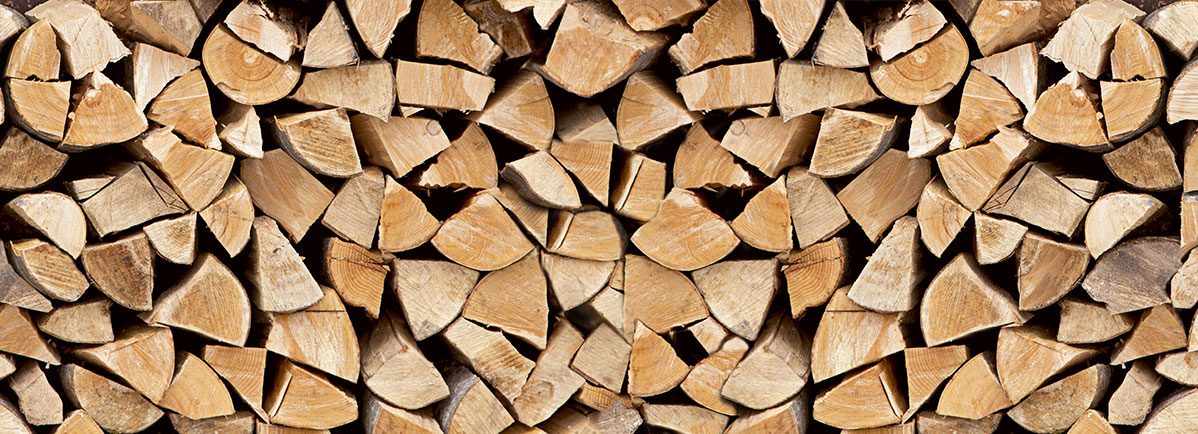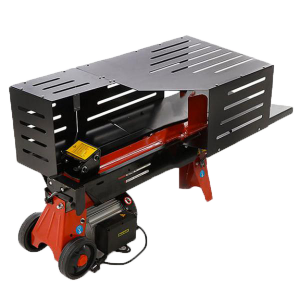A comprehensive guide to purchasing the log splitter best suited to your needs, with all its available features and categories.
The Complete Guide to help you choose the Best Log Splitter
by the Real Experts of Wood Cutting Machinery
In winter, preparing firewood for the fireplace or stove can be a slow and tiring operation if done in the traditional way with an axe and wedge. But luckily, now there is a truly effective and easy-to-use tool on the market: the log splitter. A log splitter is used to cut large logs quickly, efficiently and with minimum effort.
Theoretically, the same job can be done using a chainsaw, but the reason why it is not as effective is that the chainsaw is suitable for cutting the log into pieces of different lengths, but these pieces must then be divided by a log splitter into two or more logs to be used as firewood.
When considering the purchase of a log splitter, there may be some doubts and indecisions, especially for less experienced users, as the range of offers and prices is very wide. This purchasing guide is intended to help all users (more or less experienced) and advise them on how to choose the best log splitter for their needs.
CONTENTS
1. The log splitter: vertical or horizontal and the different types of engine
The log splitter is a very useful tool for wood cutting operations. It has become the main tool for dividing up wood logs to be used for domestic space heating. It works by exerting a force on the blade which will be able to split the wood stump by acting longitudinally on the wood fibrils. Which one to choose?
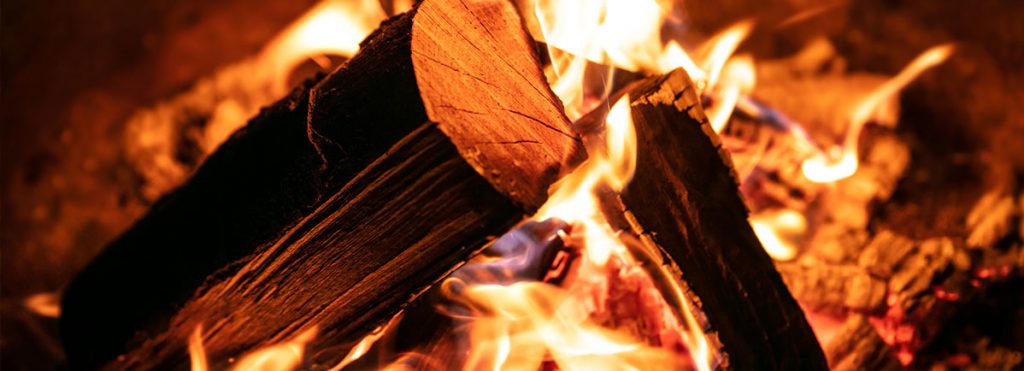
A first distinction that needs to be made concerns the structure of a log splitter itself, in fact, two types can be identified:
This first distinction relates to the different positioning of the wood logs to be split. It is also important to say that a horizontal log splitter can be more “uncomfortable” than a vertical model. In fact, if there is no solid and resistant base to place the machine, the vertical log splitter “forces” the user to work while bending over.
It is usually the vertical log splitter that is most frequently used. This is because it allows for greater work flexibility and practicality. The stump must be positioned vertically and, resting on its back, allows the wedge of the log splitter to sink better into the wood, making it easier to split the log. The wood stump can then be split exactly in half.
Finally, among the best vertical log splitters we can find some models equipped with the Ground level cutting function, which has a piston stroke so long that it reaches the log already placed on the ground by the user. The details of this feature will be further discussed later.
The main subdivision, however, concerns the power supply to the engine of a log splitter:
1.1 Electric log splitters
As for the models with ELECTRICAL POWER SUPPLY, these are undoubtedly the most popular log splitters because they all feature the possibility of supplying electricity and it is more convenient because all you have to do is connect the log splitter to the electrical socket.
Within this sub-category, it is possible to make a further subdivision according to the engine:
Single-phase log splitters are limited in terms of power (up to 12-13 tonnes with a maximum power output of 3 HP), although they are still suitable for domestic use. Prices can vary from €200 to €1200 with products ranging from a hobbyist to professional levels depending on the manufacturing brand: Chinese or European.
A fundamental aspect is the cutting capacity in tonnes: the higher this is, the more the product will be qualitatively and structurally valid and performing. However, for non-frequent cutting of clean, not knotty stumps with a diameter of 15 to 20 cm, it is best to opt for a hobby use log splitter. This feature varies from machines designed for private use (e.g. 8 to 10 tonnes of cutting capacity) to models designed for more intensive work, capable of delivering good performance with hard, slightly larger logs (10 to 12 tonnes), preferably made in Europe. The price of the models in this category may exceed €1000, but it must be said that they can boast excellent functionality in the medium to long term.
As an alternative to the single-phase models, there are log splitters fitted with three-phase motors which, due to their nature, start from a semi-professional level and go up to those suitable for industrial use. They are undoubtedly the most structurally complex, with a robust hydraulic cylinder fixed to the top of the log splitter, and the piston pointing downwards with the wedge channelled along the log splitter body on special steel guides.
Of course, electric log splitters can be divided into:
- HORIZONTAL LOG SPLITTERS
These are the most cost-effective models that feature a “standard” frame: with two square shaped steel tubulars that slide inside each other, controlled by a hydraulic circuit placed inside them and with a cutting capacity of 6 or 7 tonnes. This type of horizontal log splitters with single-phase 230V electric motor is intended for all those users who are looking for a small machine for purely domestic use, suitable for splitting small and not too hard wood. The horizontal frame structure makes them practical to use even by less experienced users. They are space saving machines equipped with small wheels (often supplied) that allow for an easy storage.
- VERTICAL LOG SPLITTERS
Hobby range single-phase vertical electric log splitters have a higher degree of robustness than smaller horizontal electric log splitters. Like horizontal models, this type of log splitters feature a standard frame structure. The thrust power can range from 6 to 9 tonnes on larger models. The electric log splitters have a height-adjustable cutting plate for positioning the log to be split and a pair of wheels for easy movement and storage. These instruments are intended for private individuals for a medium/hobby domestic use.
Heavy-duty vertical electric log splitters are equipped with a sturdy hydraulic cylinder fixed at the top, the piston facing downwards and the wedge channelled along the log splitter body on steel guides. They have powers ranging from 10 to 16 tonnes and are available in two versions:

- Hydraulic log splitters with ground level cutting function have a base support placed very close to the ground where the operator puts the wood stump. The real advantage of these log splitters (as mentioned above) lies in their ease of use: it is not necessary to lift the log to split it, but simply to place it on the base support;
- Hydraulic log splitters without ground level cutting function, equipped with a half-height adjustable base support; in this case, it is necessary to lift the log onto the cutting plate, but this type of operation nevertheless makes it possible to split the log while standing upright and then holding it firmly using the two log cradles provided. There are two different versions of these models:
- with “normal” piston stroke of 500 mm (which allows splitting on the base support only)
- with “increased” piston stroke of 1000 mm (which allows for splitting both on the base support and directly on the cutting plate already positioned at ground level without having to lift the log).
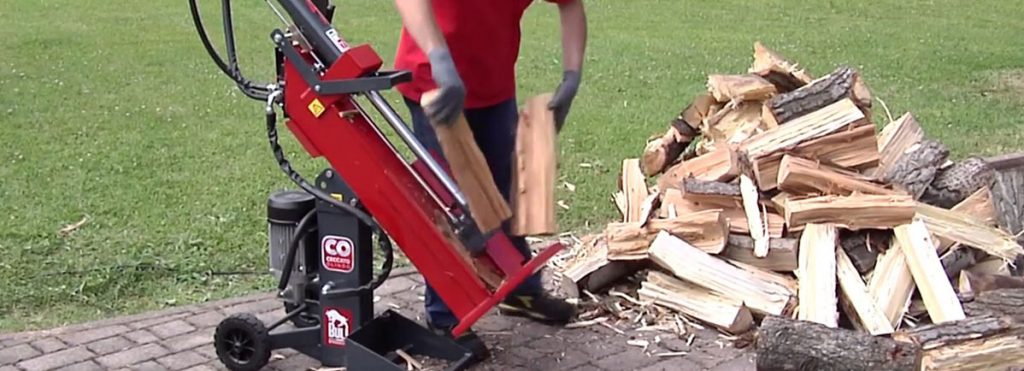
1.2 Tractor log splitters
Tractor log splitters belong to a more professional range of machinery. These tools are more akin to the world of agricultural machinery; in fact, thanks to the connection to the tractor, they allow for a higher working autonomy and are capable of delivering significantly greater performance.
Tractor log splitters come with vertical or horizontal configuration.
The vertical configuration is characterised by the external hydraulic cylinder fixed at the top, the piston is facing downwards and has the wedge channelled along the log splitter body with special steel guides. These machines provide thrust powers ranging from 10 to 35 tonnes. They can be divided into two types:
- tractor log splitters with ground level cutting function have a base support on the ground for positioning the log, so there is no need to lift it.
- tractor-mounted log splitters without ground level cutting function have a half-height adjustable log cutting plate, which allows to work in an upright position and make use of the special log cradles. There are two different versions of these models:
- with “normal” piston stroke of 500 mm (which allows splitting on the base support only)
- with “increased” piston stroke of 1000 mm (which allows for splitting both on the base support and directly on the cutting plate already positioned at ground level without having to lift the log).
1.3 Petrol log splitter
The petrol log splitter is ideal for all users who do not have access to electricity or do not own a farm tractor. It must be said that an electric log splitter draws about 3 kW of current, so it is very unlikely that such a constant supply of current will be available. Purchasing a petrol log splitter means making a choice based on practicality.
The 4-stroke engine log splitter is capable of working anywhere and in full autonomy!
4-stroke log splitters have thrust powers ranging from 10 to 20 tonnes, including both hobby and heavy-duty machines.
Petrol log splitters generally feature a standard frame structure: two square shaped steel tubulars that slide into each other, driven internally by a hydraulic cylinder. In addition, exactly like the other machine types with different power supply, they have both a vertical and a horizontal configuration.
However, it is important to mention that there is a newly developed model of petrol log splitter, which features a multi-position adjustable rotation system that allows it to have different configurations. It can be used as a vertical log splitter with a cutting plate for positioning the log very close to the ground, which allows to split it without having to lift it up, or as a horizontal log splitter which requires the operator to lift the log on the base support.
The multiple position system rotates in 5 different combinations; this system makes it very practical to use, allowing the configuration of the log splitter to be easily set and changed, according to the user requirements, the size and weight of the logs to be split.
2. The log splitter and its uses
The best log splitters are sturdy and powerful tools which allow to split large amounts of wood without the need to use the classic axe. Log splitters can prove to be truly essential for the production of firewood to feed wood-burning stoves or fireplaces. Of course, there are different models, ranging from the smallest ones to more professional machines, to suit the diversified needs of users. Regardless of their design and type of power supply, log splitters can be intended for hobby or professional use. The choice between one model or another must therefore be made taking into account the work requirements and the amount of wood to be split. So, the main division in the world of log splitters is as follows:
2.1 Hobby use log splitters

A log splitter for hobby use is usually structurally smaller and less powerful than more professional equipment.
Hobby-range vertical models have a tubular frame structure and are usually electrically powered or can even be the smallest among petrol models. The range of hobby machines includes single-phase electric horizontal log splitters: these tools are designed for those who need a small log splitter for strictly domestic use. They are ideal for splitting small-sized and not too hard wood. In fact, hobby log splitters are suitable for cutting short stumps up to a maximum length of 25 centimetres. They are ideal tools for the production of logs to feed small fireplaces.
The horizontal structure makes these log splitters very practical and easy to use even by beginners. Their small size and wheels make them easy to store, and, since they take up little space, are perfectly suitable to be used in the garden. Their frame structure is of the standard kind: it consists of a square shaped steel bearing tubular structure with an integrated hydraulic cylinder that drives the platform, which in turn exerts pressure on the wood, pushing it towards the wedge that splits the stump. What thrust power do hobby use log splitters have? From 4 to 6 tonnes.
2.2 Heavy-duty log splitters
For more frequent and heavy-duty use, it is better to move towards professional log splitters: stronger and more powerful tools with a heavier, telescopic tubular frame.
A heavy-duty log splitter is built with a large blade, guided by supports along a steel guide, which safeguards the integrity of the cylinder, even under maximum stress.
The best heavy-duty log splitters, whether electric or tractor-driven, have an oversized, reinforced double tubular frame. These machines can split hard and knotty wood of varying sizes up to a maximum of approx. 114 cm (this is made possible by additional drive controls on the top of the log splitter that allow even very large stumps to be split).
One of the most popular brands on the market for heavy-duty log splitters is Ceccato Olindo: a renowned Italian company. Ceccato Olindo manufactures combined vertical log splitters designed primarily for professionals. Such a machine can be either cardan-driven and connected to the tractor’s PTO, or current-powered, perhaps using a three-phase electric motor.
In addition, these log splitters can be equipped with 2 hydraulic pumps: one on the electric motor and one connected to the gearbox for use with a cardan shaft. These pumps provide powerful thrust and a high working speed thanks also to the professional distributor to which they are connected.
The machine is equipped with a safety support and an automatic adjustable limit switch control system.
3. The main details of a log splitter
When choosing a log splitter, these three technical specifications should be taken into account:
- the pump
- the piston and the split length
3.1 The pump
As far as the log splitter pump is concerned, it is important to check its production origin, as only pumps of ITALIAN or GERMAN production are to be considered professional: Italy and Germany are the two top countries for water pump engineering. The two elements to be assessed for a log splitter pump are flow rate and pressure.
The flow rate, higher or lower, determines the speed of the piston. The pressure is only to be considered theoretically as it is the maximum that the pump can reach. The actual pressure of the pump depends on the distributor which acts as a bottleneck.
The capacity of the oil tank is also important, as it determines the amount of liquid from which the pump can draw.
| MACHINE | FLOW RATE LITRES MINUTES | PRESSURE MAX BAR | OIL TANK LITRES | OUTER DIAMETER HYDRAULIC CYLINDER | STEM DIAMETER PISTON |
|---|---|---|---|---|---|
| HONDA GP 160 T10 MULTIPLE POSITION LOG SPLITTER | 9.50 | 180 | 6.50 | 80 | 40 |
| HONDA GX200 T11 MULTIPLE POSITION LOG SPLITTER | 9.50 | 180 | 6.50 | 80 | 40 |
| 3HP SINGLE-PHASE T10 MULTIPLE POSITION LOG SPLITTER | 7.42 | 180 | 6.50 | 80 | 40 |
| MULTI POSITION PTO T11 LOG SPLITTER | 20 | 180 | 6.50 | 80 | 40 |
| 5.5HP R4 LOG SPLITTER T16 | 32.40 | 230 | 18 | 100 | 60 |
Also very important is the presence of the double pump, whose advantage is to speed up the work. The double pump, in fact, allows to have a double piston speed, or even more, compared to the normal 3 Hp single-phase log splitter that use a single pump.
The use of the double pump allows to halve the execution time and increase the productivity of the machine.
However, it should be noted that, in the case of tractor log splitters, the double speed does not depend on the double pump. Since tractor log splitters mount a larger pump, there is no need for a double pump. Besides, on tractor-driven models it is possible to fit any type of pump.
Only smaller pumps can be fitted to electric log splitters, hence the need for a second pump. On electric models, the double pump and second speed are operated for free travel, thus increasing the stroke speed of the piston. When the log splitting begins, and the wedge meets the stump, the second pump is deactivated, the speed is halved but power is increased, both because the motor can work at full speed and deliver full power, and because the user, when the wedge touches the wood, will unconsciously be led to apply more force.
3.2 The piston, the wedge and the log splitter guides
The level of professionalism of a log splitter is determined by certain elements more than others. Heavy-duty log splitters, with a thrust power of 15 to 35 tonnes, have a heavier construction than cost-effective models and differences can also be found in details such as the piston, the wedge and the guides.
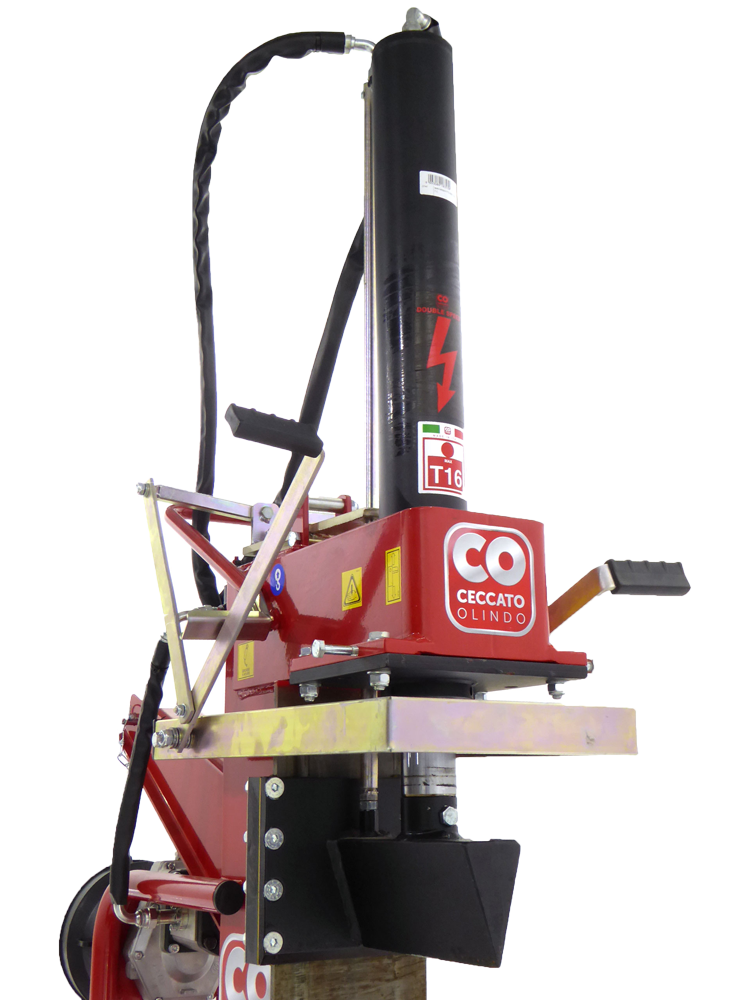
As far as the piston is concerned, its diameter is proportional to the power of the log splitter itself. A heavy-duty vertical log splitter with a thrust power of 16 tonnes can easily be fitted with a very robust and large piston cylinder, characterised by an outside diameter of 100 mm and an inside diameter of 60 mm.
This makes it possible to split hard and knotty wood logs of varying sizes up to 115 mm in height. The work is certainly facilitated by the additional drive controls on the upper part of the machine, which allows the splitting of very large stumps.
Heavy-duty log splitters feature a cast wedge: the cast and printed steel making it stronger and more durable than those fitted on less professional machines with a lighter structure.
Another key element are the guides. On heavy-duty log splitters, the piston is guided by supports along a steel guide that protects the cylinder even under maximum strain. The piston is also supported by side guides made of high-density ABS with replaceable contact thickness made of bronze. The material of the guides is high-strength, wear-resistant and, thanks to their brass sliding thickness, they preserve the steel plate on the main body of the log splitter.
The piston stroke can be adjusted as desired by the user to speed up operations and/or cut short logs. Some models of log splitters allow ground level log cutting and are equipped with an accident-prevention safety support and an automatic adjustable limit switch control system and all the safety devices to protect the user. Ground level cutting increases the practicality of use of the machine by reducing workload for the user who does no longer need to lift the log to be cut and put it on the base support.
4. Recommendations for using a log splitter
Before using the log splitter, make sure that the stumps to be split are of a regular shape.
The flat surface (which is the part on which the wedge of the log splitter acts and from which the stump is split) must be perpendicular to the sides of the log. The stump must therefore have been made with perpendicular cuts.
WARNING: If the splitting surface is inclined to the side of the log, this may cause the stump to suddenly move out of its position during the splitting process (i.e. advancement of the wedge) due to the strong pressure of the wedge, with the risk of hitting and injuring the operator or damaging the surfaces or components of the machine.
In this case, it is necessary to refine again the stump with a wood-cutting tool (chainsaw, circular saw, bandsaw, etc.) to make the surface perpendicular, before cutting it with the log splitter.
The splitting surface must have been cut very flat and must not be uneven
WARNING: If the splitting surface is uneven, this may cause the stump to suddenly move out of its position during the splitting process (i.e. advancement of the wedge) due to the strong pressure of the wedge, with the risk of hitting and injuring the operator or damaging the surfaces or components of the machine.
In this case, it is necessary to refine again the stump with a wood-cutting tool (chainsaw, circular saw, bandsaw, etc.) to make the surface perfectly flat, before cutting it with the log splitter.
The splitting operation must be carried out with the wedge well directioned on the central axis of the stump.
WARNING: If the splitting surface is positioned sideways in relation to the axis of the log, the stump may suddenly move out of its splitting position due to the strong pressure of the wedge (exerted in a condition of poor balance to the strength of the log), with the risk of hitting and injuring the operator or damaging the surfaces or components of the machine.
The flat splitting surface of the log must not have any wood knots. If it has one or more knots, the wedge of the log splitter will not be able to split the stump near these knots. It is therefore advisable not to split this type of log or else to direct the wedge at the furthest point from the knot(s) in the wood.
WARNING: splitting logs with a knotty surface or near these knots can lead to excessive strain on the log splitter and may cause the stump to suddenly move out of its position, with the risk of hitting and injuring the operator.
Also avoid making repeated attempts to split a knotty log that the machine can not cut, as this can also cause overheating and damaging of the log splitter.
The back or side of the wood shall be free from protruding branches or other irregularities that make the surface insufficiently straight.
WARNING: splitting logs with an uneven outer surface or with branches can cause the log to suddenly move out from its initial position during the splitting process (i.e. advancement of the wedge) with the risk that the pressure of the wedge may hit the operator or damage the surfaces or components of the log splitter.
The diameter of the log must not exceed the maximum diameter indicated in the log splitter datasheet
WARNING: Attempting to split diameters larger than those indicated in the technical datasheet may result in the log moving out of its position, with the risk of hitting and injuring the operator or damaging the log splitter itself.
Use of the cross splitting wedge.
The use of the cross splitting wedge (only on models where it is supplied as standard) is suitable only for small logs (max. 30 cm diameter) and for soft, clean woods, with linear wood fibres and without knots. Otherwise, by operating the control levers, the splitting attempt would most often fail, given the high strain that a four-part split entails on the hydraulic and mechanical parts of the log splitter, which in the worst cases could also cause damage to these components. Therefore, a very responsible use of this tool is strongly recommended.



